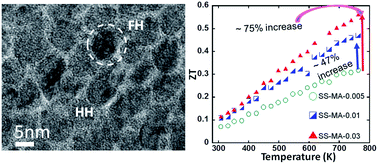Nanometer-scale interface engineering boosts the thermoelectric performance of n-type Ti0.4Hf0.6Ni1+zSn0.975Sb0.025 alloys
Abstract
Engineering the internal structure of bulk semiconductors through the introduction of nanometer-scale interfaces affords opportunities for simultaneous optimization of electronic and thermal transport properties, enabling the fabrication of nanocomposite materials with superior thermoelectric performance. Several compositions of n-type Ti0.4Hf0.6Ni1+zSb0.975Sn0.025 half-Heusler (HH)/full-Heusler (FH) composites were synthesized by a high temperature solid state reaction of the elements. Polycrystalline powders of the resulting HH(1 − z)/FH(z) composites were further processed by mechanical alloying using high-energy ball milling. Transmission electron microscopy (TEM) studies revealed the presence of small (∼20 nm) FH precipitates coherently embedded in micron-scale grains of HH/FH composites obtained after the solid state reaction, whereas nanometer-scale grains (∼20 nm) of the HH/FH composites containing very small (<10 nm) FH precipitates were observed in mechanically alloyed samples (SS-MA). The as-synthesized HH(1 − z)/FH (z) samples (SS) showed similar electrical conductivity, thermopower and thermal conductivity at all temperatures regardless of the fractions of FH inclusions. This suggests that the FH inclusions are electronically inert with regard to the matrix. Interestingly, drastic alterations of all three properties were observed on mechanically alloyed samples and the magnitude of change in various properties increases with the mole fractions of FH inclusions. For example, large reductions in the thermal conductivity (8.5 W K−1 m−1 to 4.0 W K−1 m−1 at 300 K) as well as electrical conductivity (4750 S cm−1 to 1750 S cm−1 at 300 K) were observed in all SS-MA samples compared to SS samples with similar compositions. This behavior is attributed to enhanced scattering of phonons and electrons at multiple grain boundaries generated by the mechanical alloying process. Remarkably, the magnitude of the reduction in the electrical and thermal conductivities increases with the mole fraction of FH inclusions in the samples suggesting (1) reduction in the carrier density due to trapping of low-energy carriers and (2) additional phonon scattering at nanometer-scale HH/FH interfaces. This results in large increases in the thermopower (−60 μV K−1 to −92 μV K−1 at 300 K) of SS-MA samples, which mitigates the drop in the electrical conductivity leading to large improvement of the figures of merit of mechanically alloyed Ti0.4Hf0.6Ni1+zSb0.975Sn0.025 samples.


 Please wait while we load your content...
Please wait while we load your content...